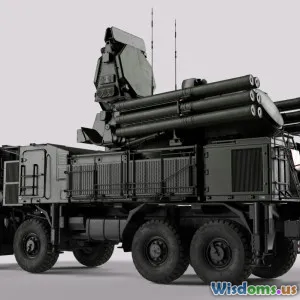
Top Five Innovations Revolutionizing Soldier Ballistic Protection Gear
12 min read Explore the top five technological breakthroughs transforming modern soldier ballistic protection gear for increased safety and effectiveness on the battlefield. (0 Reviews)
Top Five Innovations Revolutionizing Soldier Ballistic Protection Gear
Introduction: Of Bullets, Battles, and Breakthroughs
Imagine stepping onto a battlefield. For centuries, survival depended as much on courage as on the quality of armor worn. Gone are the days of clunky steel suits and heavy plates that slow movement and fatigue shoulders. Today’s soldiers carry something altogether smarter: ballistic protection gear that is light, adaptive, high-tech—and thanks to recent innovations, far more effective.
As armed conflict becomes more complex and threats escalate with modern weaponry, the need for avant-garde protection has pushed science, engineering, and materials research into overdrive. The quest is not simply about stopping bullets, but about enhancing soldier survivability, comfort, and performance.
Let’s journey through five transformative innovations that are rewriting the rulebook on battlefield protection—Innovations already fielded or on the edge of deployment in military uniforms across the globe.
1. Graphene Armor: Stronger Than Steel, Lighter Than Hope
The Science of Graphene
Developed only in 2004, graphene—a single layer of carbon atoms arranged in a honeycomb lattice—immediately drew attention for its astounding physical properties. It’s 200 times stronger than steel, incredibly lightweight, and conducts heat and electricity with unrivaled efficiency. While its discovery earned the Nobel Prize in Physics, its journey into body armor has only just begun.
Battlefield Applications
Traditional Kevlar has long been used in bulletproof vests, but it faces limits in weight, durability, and multi-hit performance. Enter graphene. Pioneering tests by researchers at Rice University and the U.S. Army Research Laboratory have shown “GRAPHENE FOAM” composites can dissipate kinetic energy more efficiently than Kevlar, potentially stopping faster projectiles at a fraction of the material weight.
Graphene-enhanced plates allow soldiers to remain agile without sacrificing protection. These are currently in advanced field trials, with labs like MIT and several defense contractors racing to scale production to military levels. Early prototypes of “graphene-based composites” have survived multiple rifle shots without penetration—something that would compromise traditional ceramic plates.
“Graphene armor could dramatically reduce the burden on troops, offering better protection with far less weight.” — Dr. James R. Kelly, Defense Materials Specialist, US ARL
Real-World Adoption
While pure graphene armor is rare due to manufacturing costs, commercially available gear increasingly incorporates graphene layers as supplements or coatings to existing materials. Soldiers in elite units and special forces are among the first to benefit, with rollout expected to expand as supply chains mature.
2. Liquid Body Armor: Flexibility That Freezes on Impact
The Magic of Non-Newtonian Fluids
It sounds like science fiction: a “liquid” vest that’s supple and soft, yet transforms into a hard, bullet-stopping shield the moment a threat appears. The key? Shear-thickening fluids, notably substances called “Non-Newtonian” liquids, which rapidly harden upon impact.
Science Meets Soldiering
Leading the charge, the Polish company Moratex, in collaboration with the Military Institute for Armament Technology, has developed vests embedded with liquid armor comprising a suspension of oxide nanoparticles in polyethylene glycol. This potent mixture behaves normally as a flexible material—but when struck, molecules lock together, distributing force instantly across a wider area and resisting penetration.
Experiments show such vests can withstand projectiles up to twice as powerful as those that defeat standard Kevlar, all while remaining thinner and considerably lighter. The implications are especially profound for law enforcement and soldiers who require agility but cannot compromise on bullet resistance.
From Lab to Battlefield
In the mid-2010s, the U.S. Army initiated live field trials at Aberdeen Proving Ground, Maryland. Soldiers reported an unprecedented blend of mobility, comfort, and confidence. Though not yet standard issue, liquid armor panels are increasingly fitted to extremities—areas traditionally challenging to protect—such as arms and legs, signifying a leap forward for full-body protection.
3. Smart Armor: Embedded Sensors and Real-Time Analytics
Sensors That Defend More Than Skin
Modern soldiers are as much data hubs as warriors. Smart ballistic gear now features integrated sensors that detect, record, and analyze kinetic impacts, blunt force, temperature changes, and even biometric data in real time.
How It Works
Companies like BAE Systems, in partnership with DARPA, have engineered vests and helmets containing shock sensors, pressure analyzers, and wireless transceivers. Houston, we really do have a problem if sensors register a high-caliber round or a blast event—commanders and medics are automatically alerted, enabling rapid triage and targeted medical support.
Beyond injury detection, sensor earmarked “smart armor” can monitor signs of physiological distress: elevated heart rates, heat exhaustion, or toxic gas exposure. All data is relayed instantly to command centers or field medics, providing a layer of defense far beyond the physical.
Facts and Figures
A 2022 U.S. Army report highlighted that deployments of sensor-equipped protection gear helped improve response times to injured soldiers by over 25%. Similarly, the British Army’s “Future Soldier” program’s use of connected body armor has recorded significant reductions in casualties due to near-instant medical assessment and intervention when under fire.
Eye to the Future
These intelligent systems lay a foundation for exoskeletons and augmented gear—think “Iron Man light”—and open the door to future upgrades like self-repairing surfaces and adaptive energy dispersion based on incoming threats.
4. Adaptive Camouflage and Stealth Materials: More Than Meets the Eye
Modern Cloaks of Invisibility
Protection is not always about withstanding impact; increasingly, it’s about not being noticed at all. Enter adaptive camouflage and “stealth materials,” inspired by chameleons and cephalopods, and enabled by microelectronics and nano-engineered fabrics.
Technology Explained
Today, advanced body armor can alter its visual, infrared, and thermal profiles. Canadian and European militaries are experimenting with “Metaflex” and similar adaptive textiles that dynamically change color or temperature reflection, visually blending soldiers into any environment, whether amidst snow, jungle, or desert.
Fishnet-linked micro-LEDs, flexible e-ink screens, and conductive threads enable complex patterns that can shift within moments. This isn’t limited to visual camouflage; reducing heat signatures against enemy sensors exponentially minimizes the risk of being targeted by infrared-guided weapons or night vision-equipped adversaries.
Military Deployments
Israel, the UK, and the US lead the pace, with special forces’ camouflage uniforms integrating “adaptive skin” panels since 2021. Feedback from the British SAS and US Rangers highlights not only reduced visibility to adversaries but increased confidence during covert or rescue operations.
“Invisible to the naked eye, and to sensors. That’s true protection.” — Lt. Col. Emma Whyte, British Army, Project Cameleer
Civilian Spin-offs
Such materials are already revolutionizing search-and-rescue and police SWAT operations, offering crucial advantages in urban conflict or when responding incognito.
5. Lightweight Ceramic and Composite Armor: Redefining Resilience
Beyond Steel: The Evolution of Hard Plates
Ceramic armor has served as staple protection for decades, prized for its resistance to high-velocity rifle rounds. However, scientists have advanced well beyond basic ceramics—using silicon carbide, boron carbide, titanium diboride, and hybrid composite layering.
Lighter, Thinner, Stronger
Recent composite plates are up to 40% lighter and thinner than their ancestors. For instance, a Defense Advanced Research Projects Agency (DARPA) initiative using boron carbide reinforcements saw body armor plates shed several pounds yet retain the ability to stop repeated strikes from armor-piercing ammunition.
Nanotechnology further boosts resilience. By incorporating carbon nanotubes and advanced polymer resin in composite layers, researchers have achieved unprecedented multi-hit durability. The result: plates that do not shatter or splinter—reducing surgery for embedded fragments and ensuring ongoing protection after multiple impacts.
In Service
Boron-carbide SiC composite plates are now standard issue in the US Army’s Enhanced Small Arms Protective Insert (ESAPI) and Australia’s Soldier Combat Ensemble. Tests reveal soldiers can engage in rigorous activity, fast marches, and obstacle courses with an immense reduction in fatigue and risk of injury.
Quotes and Testimonials
"The new plates are a game-changer. Lighter, tougher, and way more comfortable," states Sgt. Nathan Brooks, 4th Infantry Division. Troops echo these sentiments globally as new gear becomes essential kit for frontline fighters.
Conclusion: The Future of Protection – Merging Man and Machine
While war’s inherent dangers will never disappear, the frontlines of ballistic protection continuously shift forward with every scientific advance. Once, armor simply shielded; today, it communicates, reacts, and even allows soldiers to vanish in plain sight.
As these top five innovations demonstrate, the convergence of nanotechnology, sensor engineering, and material science has spawned the most effective protective gear in military history. Future projections forecast the seamless merging of biological resilience with digital upgrades—where exosuits, totally transparent armor, or even bioengineered fabrics respond autonomously to whatever the battlefield throws next.
The benefits ripple far beyond the barracks. Police, emergency workers, and even athletes stand to gain from these military-driven innovations. What was once “sci-fi” becomes reality—spurring relentless progress in which protection and performance work in concert.
Let this new understanding not merely awe, but inspire—for in the relentless traffic between laboratory and battlefield, today’s breakthroughs mean tomorrow’s lives saved, and the permanence of spirits returning home, unscathed, from the fog of war.
Rate the Post
User Reviews
Popular Posts

















